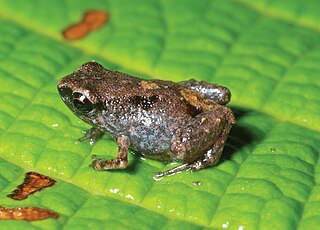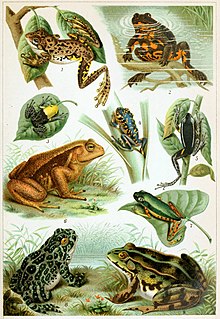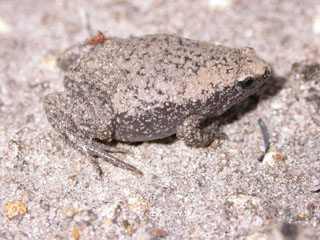
The Asterophryinae are a subfamily of microhylid frogs distributed in an area from the Peninsular Malaysia through the Malay Archipelago to northern Australia.

Barygenys is a genus of microhylid frogs. They are endemic to New Guinea and the adjacent Louisiade Archipelago. So far only known from Papua New Guinea, the range of the genus is expected to reach Papua province in the Indonesian part of New Guinea. Despite not being known from Papua, common name Papua frogs has been suggested for them.

Albericus is a genus of microhylid frogs endemic to New Guinea. These are small frogs with maximum body length around 27 mm. The genus was described in 1995, when three species in Cophixalus were separated as a new genus. The genus name Albericus is the Latin form of Alberich, shape-shifting dwarf in the epic poem Nibelungenlied. Several species derive also their specific names from Nibelungenlied, e.g. A. siegfriedi from Siegfried and A. fafniri from Fafnir.

Aphantophryne is a genus of microhylid frogs found in New Guinea and in Mindanao, the Philippines. Originally described by Fry in 1917, Richard G. Zweifel considered in 1956 Aphantophryne synonymous to Cophixalus. The genus was resurrected in 1989 to house two new species in addition to the type species, A. pansa. A molecular study on the subfamily Asterophryinae in 2017 revealed that two species originally included in the genus Oreophryne were more closely related to Aphantophryne than to other Oreophryne, and were consequently moved to this genus. The study also revealed a number of undescribed species.

Choerophryne is a genus of microhylid frogs endemic to New Guinea. These frogs are small, with the body length measured from snout to vent between 11–23 mm.

Bewani Mountains is a mountain range in northwestern Papua New Guinea. Together with the Torricelli Mountains and Prince Alexander Mountains it forms the North Coastal Range of Papua New Guinea. Highest point of the mountains is at 1,960 m.
Choerophryne sanguinopicta is a species of frogs in the family Microhylidae. It is endemic to southeastern Papua New Guinea and only known from the vicinity of its type locality, the northern slope of Mt. Simpson in the Owen Stanley Range, Milne Bay Province, although it is expected to occur more widely. The specific name sanguinopictus, from Latin for sanguis ("blood") and pictus ("painted") refers to the distinctive red blotching and punctations characteristic for this species.
Asterophrys leucopus is a species of frog in the family Microhylidae. It is endemic to northwestern Papua New Guinea where it is known from three locations: Stolle Mountain in the Sandaun Province—its type locality, and Hunstein Mountains in the East Sepik Province and the Bewani Mountains in the West Sepik Province.
Callulops marmoratus is a species of frog in the family Microhylidae. It is endemic to Papua New Guinea and only known from its type locality, Crater Mountain Wildlife Management Area in the southwestern Chimbu Province, on the southern escarpment of the New Guinea Highlands.
Cophixalus balbus is a species of frogs in the family Microhylidae. Molecular data suggest that it might belong to the genus Oreophryne. It is known from the vicinity of its type locality in Yapen island, Papua Province, Indonesia, as well as from the Hunstein Mountains and Bewani and Torricelli Mountains in Papua New Guinea.
Oreophryne alticola is a species of frog in the family Microhylidae. It is endemic to West Papua, Indonesia, and only known from its type locality on the New Guinea Highlands. Its natural habitat is subalpine grassland at elevations of 3,500–3,900 m (11,500–12,800 ft) asl. No significant threats to it are known.
Oreophryne brachypus is a species of frog in the family Microhylidae. It is endemic to the island of New Britain, in the Bismarck Archipelago of Papua New Guinea. Common name Gazelle cross frog has been coined for it.
Oreophryne geislerorum is a species of frog in the family Microhylidae. It is endemic to Papua New Guinea where it is known from the northern coast between the tip of the Huon Peninsula and south and east to Kokoda and Popondetta. The specific name geislerorum honours two German taxidermists, Bruno Geisler and his brother Herbert Geisler.
Oreophryne inornata is a species of frog in the family Microhylidae. In Papua New Guinea it is endemic. Its natural habitats are subtropical or tropical moist lowland forests and subtropical or tropical moist montane forests.
Oreophryne insulana is a species of frog in the family Microhylidae. It is endemic to Papua New Guinea. Its natural habitat is subtropical or tropical wet/damp environments montane forests.
Aphantophryne parkeri is a species of frog in the family Microhylidae. It is endemic to the north coast of New Guinea and only known from Matapan and the Bewani Mountains in the West Sepik Province, Papua New Guinea, and from Sentani in the Papua Province, Western New Guinea (Indonesia). This species was formerly included in the genus Oreophryne, but was in 2017 moved to Aphantophryne based on molecular data. The specific name parkeri honours Hampton Wildman Parker, an English zoologist and herpetologist. Common name Parker's cross frog has been coined for it.
Cornufer cheesmanae is a species of frog in the family Ceratobatrachidae. It is endemic to New Guinea and found in the Cyclops Mountains and Bewani Mountains. The specific name cheesmanae honors Lucy Evelyn Cheesman, an English entomologist, explorer, and curator at London Zoo. Common name Cheesman's wrinkled ground frog has been coined for it.

Papurana papua is a species of true frog, family Ranidae. It is endemic to New Guinea and found in the northern part of the island in both Indonesia and Papua New Guinea as well in some offshore islands. Common name Papua frog has been coined for it.

Oreophryne furu is a species of microhylid frogs endemic to the Mamberamo River basin in Papua, Western New Guinea. It is distinguished from other related species by its small size, unique call and egg-guarding behaviour.
Mantophryne axanthogaster is a species of frog in the family Microhylidae. It is endemic to Papua New Guinea. Its natural habitat is lowland rainforest, cloud forest, and it can be commonly seen near streams.











